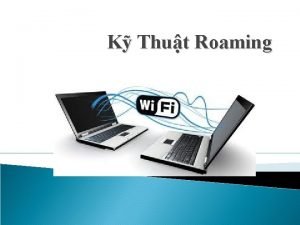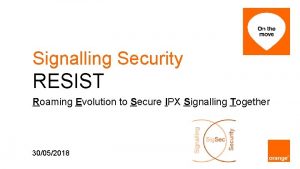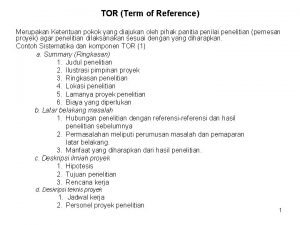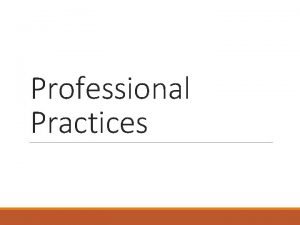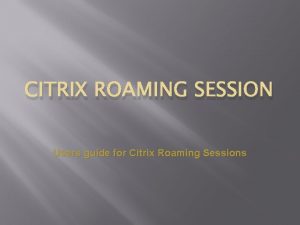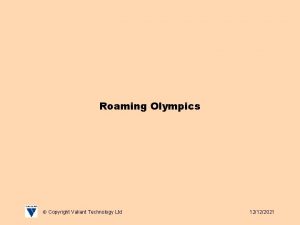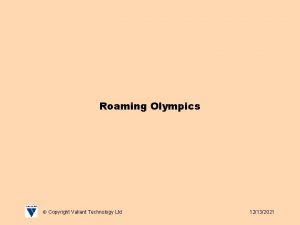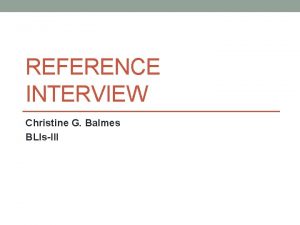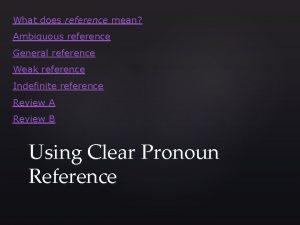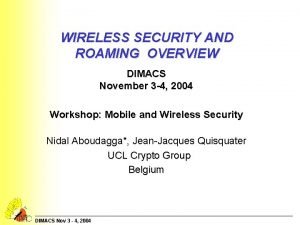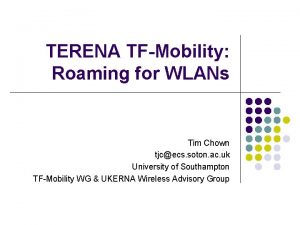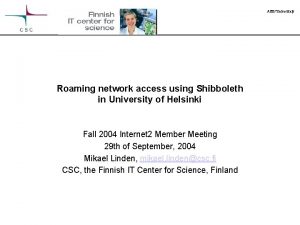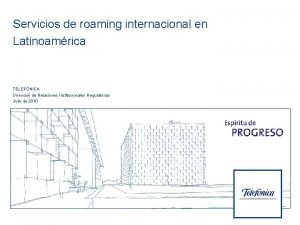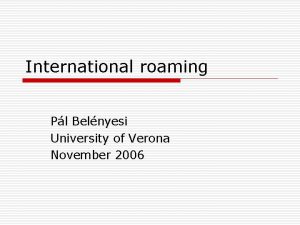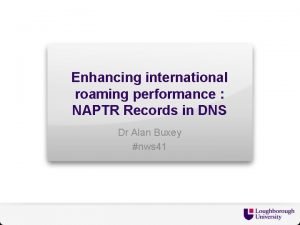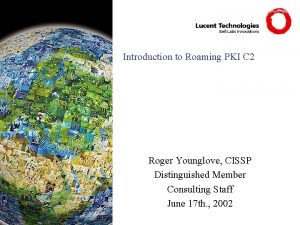Roaming What is it The term roaming reference


































- Slides: 34

Roaming

What is it? "The term "roaming" reference has never been clearly defined. Generally, it has been used to describe services provided in a non-traditional manner: roving, outpost, offsite and point of need reference services. In essence, it is anything occurring away from the confines of the reference desk. “ Kramer, E. (1996). Roving reference: A case study in a small academic library. Reference Services Review, 24(3), 67 -80.

Why do it? For many people approaching an Enquiry desk can be a daunting experience and roaming support can help overcome these barriers while also providing a referral option for staff on the Enquiry desks if they are unable to leave the desk to take a user to the area of the Library they require. Uo. P Library - RFID operating plan (June 2012)

Why do it? • To help library users feel more confident, happier and become more selfsufficient • To encourage library users make better use of the library and its resources – get more out of the service • Roaming helps form better relationships between library users and library staff • Roaming helps library staff to better understand the needs of library users, and also how their ‘office’ job fits in to the wider work of the library • Roaming helps improve staff knowledge – if you don’t know the answer to a question you should find out the answer • Through roaming library users’ experience of the library improves, they improve their knowledge and therefore will hopefully do better in their studies

Other libraries do it too!

What it isn’t • Jumping on people as they walk in • Glib and patronising ‘have a nice day’ scripts • Being so busy with work that clients feel awkward approaching

Roaming: Feels a bit scary!

Roaming: Feels a bit scary! Outside of our comfort zone I might not understand the question I might not know the answer I might be made to look stupid Clients won’t want me bothering them If I ask someone if they need help they might say no or even worst get cross with me BUT remember that is how our clients feel about asking us a question

Roaming: Feels a bit scary! Outsideof ofour their comfort zone They’re I might notnot sureunderstand what question they need to ask They I might not know understand the answer The person I might theybe askmade will think to look they’re stupid Staff Clients won’t want them meinterrupting bothering them their work If they I ask someone if they for need help they help might they might say no say orno even or even worst get cross with them me BUT remember that is how our clients feel about asking us a question

How to develop confidence • Focus on your strengths and build upon them • Catch yourself doing good things • Catch others doing things well • Develop your knowledge • Have a can do mindset – I can do this, not I will try, I have to • Be alert to negativity The best thing you can do to build confidence is to PRACTICE!

First impressions When you interact with a client what % of your communication is • Verbal (the words you use) 7% • Vocal (your tone of voice) 38% • Non-verbal (body language etc) 55%

The Think Link Your body follows where your mind goes

The think link • What you are thinking will impact on your body language and therefore your approachability? • How your thinking effects your body language is subconscious, at least for the first few seconds and we can’t change it. However once it comes into our consciousness thoughts we can recognise it and change it. • We can change it by smiling and changing our posture but we also need to change our thoughts.

The think link • Body language also works the other way too! • Body language doesn’t just signal what you’re thinking. It can also shape what you are thinking. • If you stand tall, and have a confident posture, your body will manufacture more testosterone, and less cortisol (a stress hormone). You’ll actually start to feel more confident and powerful, and you will believe that you are so.

Body language • Be relaxed and smile • Stand up straight and have an open posture • Make eye contact • Stay focused • Look at the speaker

Building rapport Be yourself Be genuine Ask open ended questions Active listening Show empathy Be conversational rather than corporate Be honest Maintain confidentiality Be aware of you body language and tone of voice Avoid technical jargon Don’t interrupt and don’t make assumptions Discuss areas of common interest

The rapport scale Good Rapport No Rapport – Negative Rapport

When to approach How do we know when someone needs help ? Discuss

Reading other peoples body language 4 types of customers • Driver • Expressive • Amiable • Analytical

The Driver Customer Type

How to recognise The Driver Direct Minimum concern for relationships Tendency to reject interaction Need control, action, results Quick response time Verbal Fast talker Loud Tells/gives orders Focus on result Uses facts/data Non Verbal Pointing Leans forward Direct eye contact

How to deal with the Driver customer type • Give facts clearly and immediately — small talk should not cause unnecessary delays • Remember brevity and clarity are appreciated • Allow them to make their own decisions; keep your suggestions short and relevant

The Expressive Customer Type

How to recognise he Expressive Rapid reaction time Maximum effort to involve Minimum concern for routine Don’t like isolation Need excitement, acceptance and personal approach Verbal Fast Loud Focuses on people Uses stories and opinions Non Verbal Leans forward Talks with hands Openly expressive Casual posture

How to deal with the Expressive customer type • Expressives tend to get off topic very quickly so be patient. • Let them talk but try to steer the conversation back to the point • They dislike details, they’re more interested in results • They want you to listen carefully • May not be very good at listening to your answer

The Amiable Customer Type

How to recognise the Amiable customer type Unhurried reaction time Minimum concern for effecting change Supportive Tendency to avoid conflict Need for acceptance Verbal Slower/ wordy Fewer statements Softer Focus on people Non Verbal Hands relaxed Learns back whilst talking Casual posture

How to deal with the Amiable customer type • Include some social conversation • Ask them occasionally if they’re satisfied with the service provided • Let them talk, and be sure to listen • Remain patient • Keep the pace of the conversation unhurried

The Analytical Customer Type

How to recognise the Analytical customer type Maximum effort to organise Minimum concern for relationships Tendency to reject involvement Cautious action Need for accuracy, being right, correctness Verbal Slower Focuses on the task Uses facts, policies Non Verbal Closed palms Leans back whilst talking Indirect eye contact and theories Rigid posture

How to deal with the Analytical customer type • Provide a lot of information • Explain the details, when necessary • Avoid social conversation • Be patient and provide time for a decision to be made • Focus on being accurate • If you talk fast, slow down and provide time for the customer to think

Guidelines You must wear your staff card on a lanyard (obtainable from Sian) when roaming Start and end your roaming session at the information desk on the ground floor in order to ensure a smooth handover You may carry with you the i. Pad or the Google Nexus 7 device if you are comfortable doing so (available from ground floor office) but be aware of its location at all times Focus on the roaming 'hot spot' areas and 'check-in' with the information desk on the ground floor if it is quiet Looking at clients and approaching them if they look unsure is better than waiting for them to ask. However, if they look confident, leave them to it! The aim is to start the process of helping clients to help themselves if possible, so show them how to use the library catalogues or the self-service terminals if appropriate, without long explanations. Just give them enough information to get them going

Guidelines Take clients to where they need to go (as much as possible) rather than waving in the general direction Your role as a roamer is to offer a friendly face rather than police noise and behaviour. You can use positive reinforcement e. g. "you can use your phone in the atrium", but let the security guard know if you have any concerns If you can't answer or if the question is likely to take a lot of answering, take clients to an information desk and if possible, refer them on with a warm handover i. e. explain the enquiry to the member of library staff, checking with the client for accuracy Simple tasks such as clearing, may be carried out whilst you are roaming

Questions
 Laura weems
Laura weems Roaming through romans
Roaming through romans Sol
Sol Roaming wifi là gì
Roaming wifi là gì Minute internationale orange incluse in abonament
Minute internationale orange incluse in abonament Cisco umbrella
Cisco umbrella Nctu vpn
Nctu vpn Ipx roaming
Ipx roaming There is a languid emerald sea meaning
There is a languid emerald sea meaning Reference node and non reference node
Reference node and non reference node Reference node and non reference node
Reference node and non reference node Objectives of mudaliar commission
Objectives of mudaliar commission Contoh skedul kegiatan
Contoh skedul kegiatan Term of reference (tor)
Term of reference (tor) Fraction sequence
Fraction sequence Difference between long term and short term liabilities
Difference between long term and short term liabilities Example of short term goal
Example of short term goal Short term human resource planning
Short term human resource planning Minterm and maxterm expansion
Minterm and maxterm expansion Term-to-term rule
Term-to-term rule Long medium and short term planning in primary schools
Long medium and short term planning in primary schools Short term finance planning
Short term finance planning Position to term rule worksheet
Position to term rule worksheet Rules in finding the nth term
Rules in finding the nth term Long term memory vs short term memory
Long term memory vs short term memory Difference between long term and short term liabilities
Difference between long term and short term liabilities Term to term rule
Term to term rule điện thế nghỉ
điện thế nghỉ Thế nào là sự mỏi cơ
Thế nào là sự mỏi cơ Trời xanh đây là của chúng ta thể thơ
Trời xanh đây là của chúng ta thể thơ Voi kéo gỗ như thế nào
Voi kéo gỗ như thế nào Slidetodoc
Slidetodoc Các số nguyên tố
Các số nguyên tố Thiếu nhi thế giới liên hoan
Thiếu nhi thế giới liên hoan Fecboak
Fecboak



